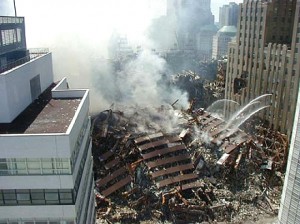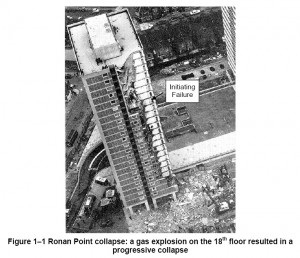2012-05-02: Last week, I attended joint meetings of CIB W14: ‘Fire Safety’ … and ISO Technical Committee 92: ‘Fire Safety’, Sub-Committee 3: ‘Fire Threat to People and the Environment’ & Sub-Committee 4: ‘Fire Safety Engineering’ … in Thessaloniki (Salonika), Greece.
The relationship between these two independent groups is symbiotic … ISO TC 92 develops International Fire Standards, while CIB W14 is the pre-normalization forum for discussion and action on a comprehensive approach to Fire Research and Innovation.
I should add, here, that CIB W14’s Aims & Objectives were substantially updated at our meeting in Thessaloniki … and I presented the CIB Research WG IV Reflection Document: ‘Structural Reliability & Fire-Induced Progressive Damage’ for discussion … which was lively, but far too short !
.
While I was away, however, the following question was posed by Mr. Panagiotis Kotsovinos, on the Society of Fire Protection Engineers (SFPE-USA) Page of LinkedIn (http://www.linkedin.com/groups?gid=96627).
” I would like to please explain a bit more why the term ‘Fire-Induced Progressive Damage’ is preferred over ‘Fire-Induced Progressive Collapse’, and what is the confusion that exists widely as you say with the later definition ? “
Firstly, apologies for the late reply. This was due to my absence from base … I am not continuously ‘plugged-in’ to the virtual environment while travelling. But, I also wished to respond to this and other queries after some thought. The issues raised are important.
Very briefly … it was NIST, in its 2005 Report, which introduced the term ‘Fire-Induced Progressive Collapse’ to a wide audience. No definition, or elaboration, of this structural concept was provided in either the 2005 or 2008 Recommendations. There is no confusion caused by ‘Fire-Induced’.
The reason I have been so quick to focus in on the distinction between ‘Damage’ and ‘Collapse’ is because we went through this whole debate, in Ireland … starting at the end of the 1980’s and continuing on through to the middle of 1990’s. Because … in January 1987 … a Multi-Storey Apartment Block, called Raglan House, collapsed as a result of a gas explosion. Two people were killed. An examination of records at the time will reveal the same general confusion about technical terminology. And … following the collapse, the Structural Engineering Profession was in disarray.
After a considerable amount of time witnessing, at close hand, these events … I formed the strong opinion that the proper connection of vertical and horizontal structural elements in a building was, and continues to be, a fundamental principle of all good structural engineering design … no matter what the height of the building.
.

.
Tackling the current confusion over technical terminology …
In 1987, Raglan House collapsed in Dublin. In 2001, World Trade Center Building 7 collapsed in New York City.
In English … the word Collapse can have the following meanings, which are very broadly similar …
- To fall down or cave in suddenly: the whole building collapsed ;
- To fail completely ;
- To break down or fall down from lack of strength ;
- To fold (furniture, etc.) compactly or (of furniture, etc.) to be designed to fold compactly ;
- The act or instance of suddenly falling down, caving in, or crumbling ;
- A sudden failure or breakdown.
[from Latin, from collabi to fall in ruins, from labi to fall]
.

.
Please examine the photograph above. Ronan Point (later demolished) was a 22 Storey Residential Tower Block in London, England. In May 1968, this building suffered Disproportionate Damage as a result of a gas explosion. As is clear from the photograph … it did not Collapse.
Disproportionate Damage
The failure of a building’s structural system: (i) remote from the scene of an isolated overloading action; and (ii) to an extent which is not in reasonable proportion to that action.
.
Let me now return to the CIB Research WG IV Reflection Document: ‘Structural Reliability & Fire-Induced Progressive Damage’ … where I began by stating …
Fire-Induced Progressive Damage in Buildings is distinguished from Disproportionate Damage – a related but different structural concept – by the mode of damage initiation, not the final condition of building failure. Until this phenomenon is properly understood, and unless it is impeded, or resisted, by building design … Fire-Induced Progressive Damage will result in Disproportionate Damage … and may lead to a Collapse Level Event (CLE), which is entirely unacceptable to the general population of any community or society.
… and, later in the document, provided this definition …
Fire-Induced Progressive Damage
The sequential growth and intensification of structural deformation and displacement, beyond fire engineering design parameters, and the eventual failure of elements of construction in a building – during a fire and the ‘cooling phase’ afterwards – which, if unchecked, will result in disproportionate damage, and may lead to total building collapse.
.
Quickly Concluding …
‘Progressive Collapse’ is not the same as ‘Disproportionate Collapse’ … and while total building collapse may be the condition of final building failure, this will certainly not always be the case. Therefore … ‘Damage’ is the more correct word to use than ‘Collapse’.
To go even further … it should not be necessary to have to use the word ‘total’ in the first sentence above.
.
Reminder … Please Read the Reflection Document …
The purpose of the Reflection Document issued by CIB W14 Research Working Group IV is to examine the ‘hot form’ structural concept of Fire-Induced Progressive Damage, and to propose a critical update to fire engineering design practice. It is also intended to encourage a wider discussion about some of fire engineering’s fundamental tenets, and the future direction of our profession in a rapidly evolving trans-disciplinary approach to the design, construction and operation of a Safe and Sustainable Built Environment.
Let me repeat again … and as I emphasized in Greece … ALL comments on the Reflection Document are most welcome !
.
.
END


